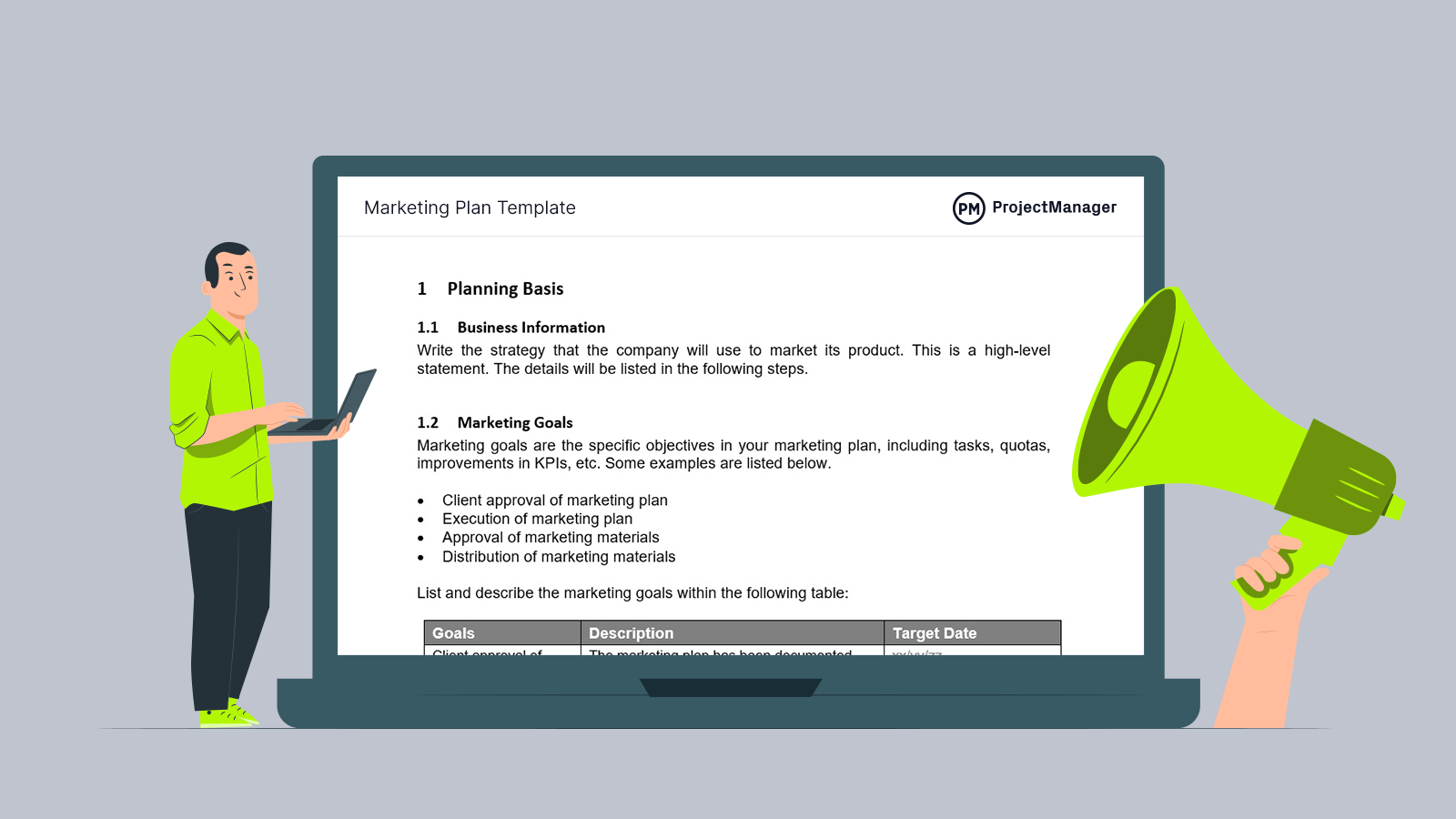Marketing plans involve a lot of work. Get a headstart by using our free marketing plan templates for Word. It takes you through all the phases, activities and scheduling necessary to carry a campaign from idea to successful execution.
Then, once you’ve got everything worked out at a high level, open the marketing plan template in ProjectManager. It lets you build a living, breathing marketing plan and schedule that your whole team work on together, in real time. Choose from five different work views: task list, kanban board, Gantt chart, calendar and spreadsheet. There’s even dashboards and reports for campaign insights. Get started for free and build a better marketing plan.
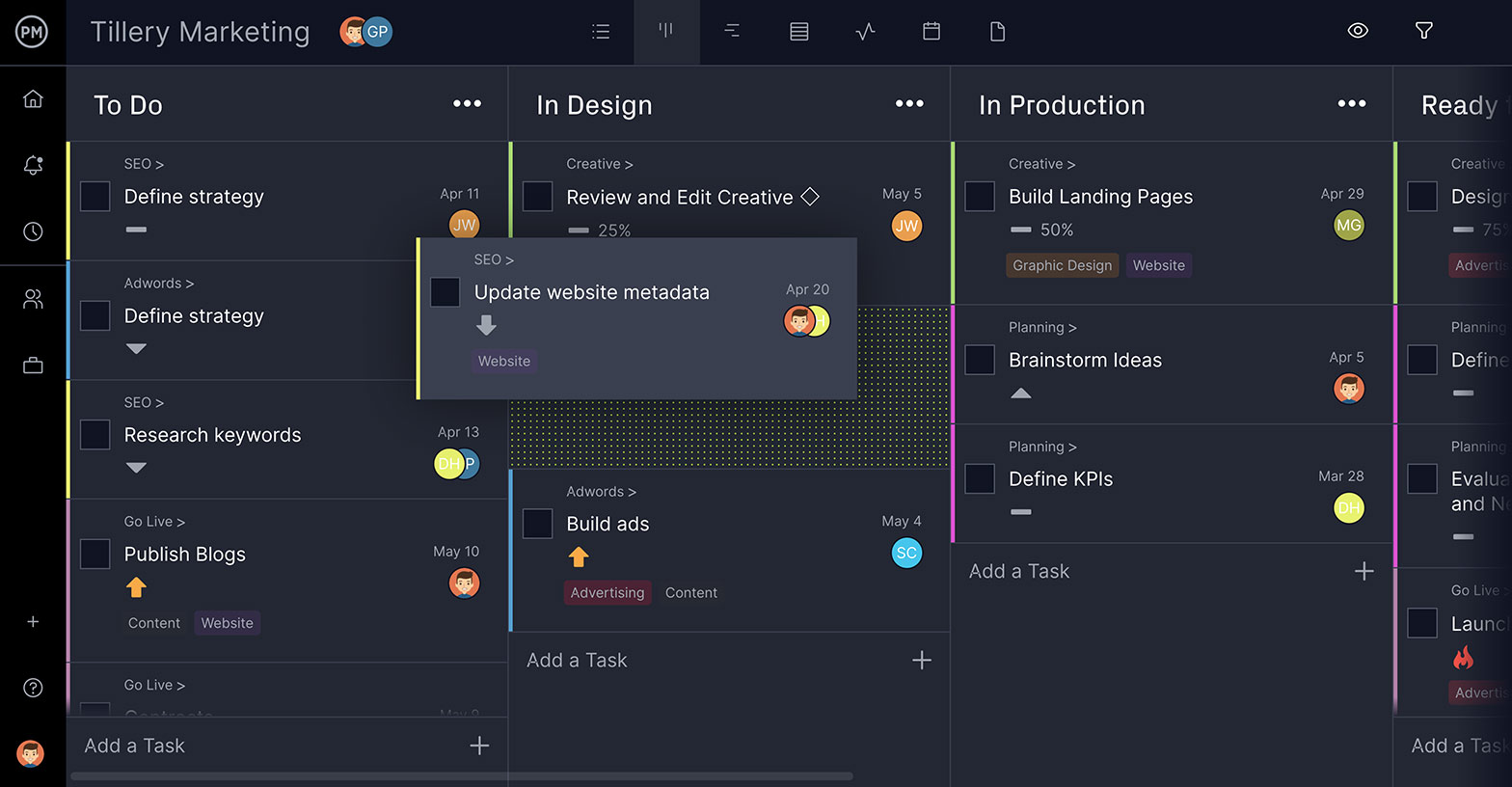
What Is a Marketing Plan?
A marketing plan is a document that outlines your marketing strategy and how to implement it. It usually looks forward over a year, though it can be tuned for monthly or quarterly campaigns.
The marketing plan will include the following items:
- Marketing and advertising goals over the period
- Current marketing position
- Scheduled tasks charted over a timeline, with start and end dates
- Key performance indicators (KPIs) that will be tracked
- Target market and audience
Therefore, the marketing plan offers a high-level view of the who, what, where, why and how of the marketing campaign. This gives a business the opportunity to think through what is necessary to effectively market their brand, product, service, etc.
The more thorough your marketing plan, the more likely it will achieve the goals and objectives of your marketing strategy. That’s why this marketing plan template is so important.
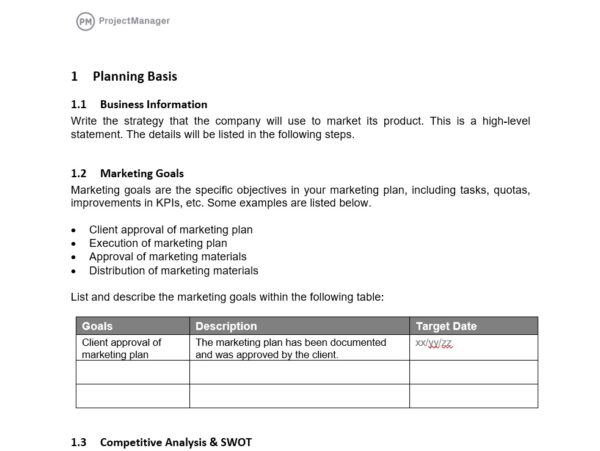
Why You Need a Marketing Plan Template
ProjectManager’s marketing plan template saves you time by providing an outline, so you need only fill in the blanks. It can also be reused each time you need to create a new marketing plan, whether that’s monthly, quarterly or annually.
More generally, a marketing plan gives you a framework by which to promote your product, service or brand. It allows you to understand the market and potential audience through research and then develops messaging that speaks to their needs.
Advertising might seem like magic, and in many ways, it remains a mystery, but by using a marketing plan template you can reduce the risk and raise your chance of success. That’s because the marketing plan template allows for a great deal of research, so your campaign isn’t a random or unintuitive message but rather a campaign that is fine-tuned to the needs and wants of an audience.
As your marketing plan unfolds, use marketing project management software to further fine-tune your marketing campaigns. ProjectManager lets marketing teams plan, execute, track and report on their campaigns in a single, online location. Collaboration is easy and all the data updates are in real time. Whether you want to build your campaigns with Gantt charts, sheets, task lists, kanban boards or calendars, ProjectManager has you covered. There’s no better tool for planning and executing your marketing campaigns. Try ProjectManager for free today.
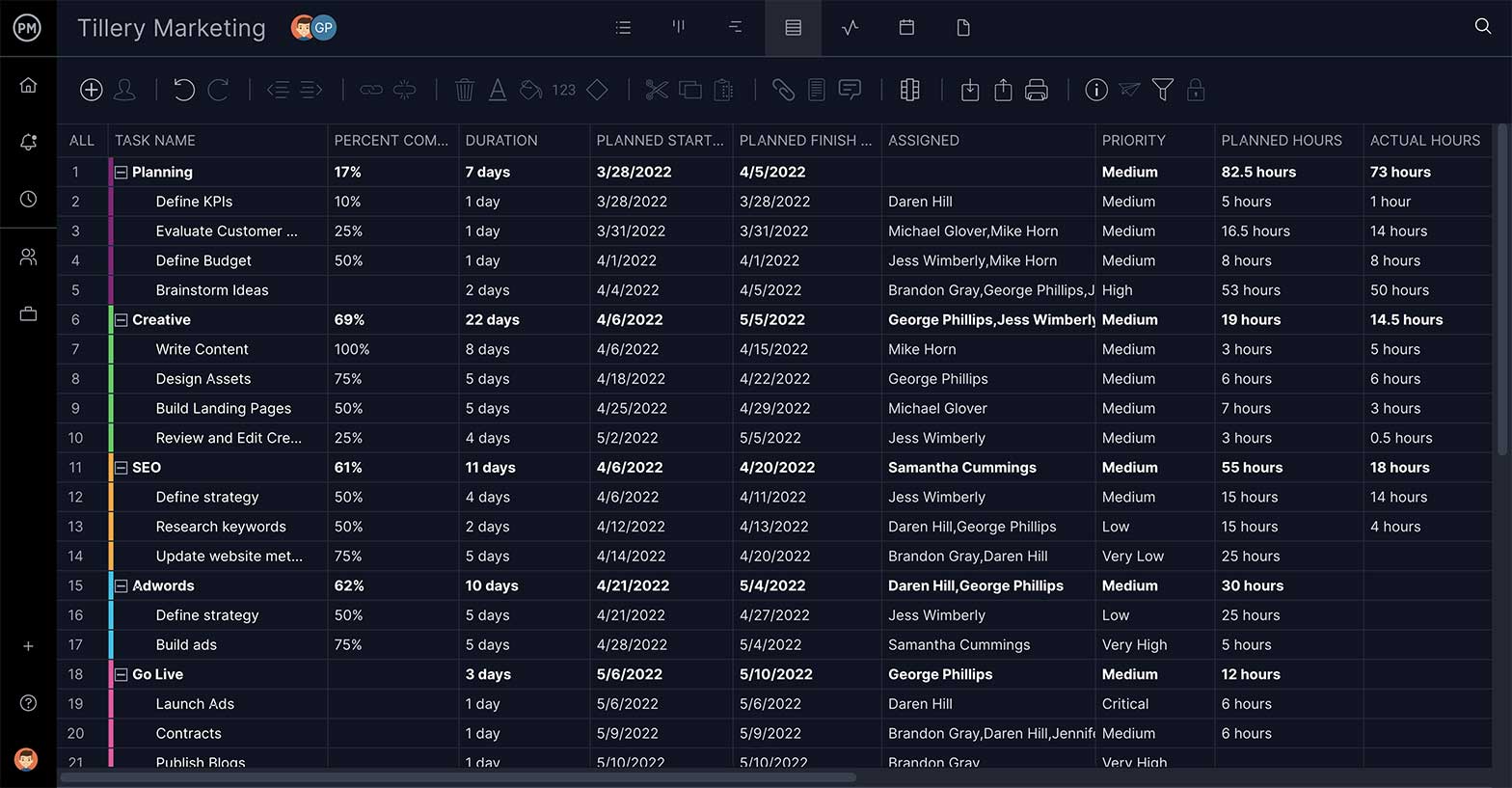
When to Use a Marketing Plan Template
A marketing plan template should be used after the strategy has been decided on, but before the campaign starts. That’s the basic contours of this marketing plan template. More accurately, making a marketing plan is a process, one that starts early and doesn’t end until the campaign it defines has been completed.
In truth, the marketing plan begins with a discussion of the business strategy. Since that strategy is the lodestar that the marketing plan will follow, it needs to be part of the brainstorming that creates a marketing strategy. That will include important aspects of the marketing plan template, such as defining the niche to be exploited and the target audience.
The marketing plan template remains a live document and is never complete until the marketing push has run its course. As you execute your advertising, the marketing plan template will have to be constantly reviewed and revised as things change. The versatility of the marketing plan template is one of the reasons it’s such an important arrow in your marketing quiver.
Who Should Use the Marketing Plan Template?
The marketing plan is used by the entire marketing department of a company, but the chief marketing officer is responsible for leading the creation of the marketing plan. They will usually delegate sections of the marketing plan to various team leaders in the marketing department. But everyone is usually involved to some extent.
Research is an important component of the marketing plan template and can be completed by a third party or done in-house, depending on the structure and size of the company. Other aspects of the plan, such as activities and scheduling, will be led by the marketing leadership team after a strategy, market segment and target audience have been determined.
Once the marketing push is executed, the whole team will be employed. The marketing plan template will then be a vital roadmap that keeps the team focused on the tasks at hand and allows managers to track progress, ensuring that the project is on schedule and within the agreed-upon budget.
How to Use ProjectManager’s Marketing Plan Template
ProjectManager’s free marketing plan template for Word in a multi-page document that is customizable to fit your needs.
Cover Page
This is where you can add your company logo and the name of the marketing plan.
Document Control
This is where you track the marketing plan. There’s an information chart that captures the ID of the plan, the owner, the date it was issued and when it was last saved, with the file name. There’s another chart to capture all the versions, as the marketing plan is likely going to be revised many times throughout its life cycle. The chart allows you to note the version, the date that revision was made and then a space to note all the changes that were made.
The document control is complete with a chart that lists all the people involved in the approval process. That includes the client, CMO, creative director and potentially many others. There are extra rows to add those people to your list. Each person has a place to add their name, sign the document and add the date of their approval.
Table of Contents
Because this is going to be a long document, there is a table of contents to make it easier to jump to a section.
Instructions
Following the table of contents is an instructional page that can be deleted but can prove helpful, especially if this is your first attempt to create a marketing plan. The template guide has a brief description of what a marketing plan is, including what’s included.
The next paragraph explains when to use a marketing plan, which is followed by a brief explanation of how to use this template. Again, these pieces are all informational and can be removed.
Planning Basis
The next page is about the planning basis. This is broken into subsections.
- Business Information: The first item is the business information, which is a high-level description of the strategy employed to market the project. The details will follow.
- Marketing Goals: Then you’ll want to list your marketing goals, which are the specifics in your marketing plan, such as tasks, quotes, etc. There’s an enclosed chart to help you collect these. You can also put KPIs (key performance indicators) in there, but you’ll have a section to go into more detail later in the plan.
- Competitive Analysis: A competitive analysis is where you list your competitors’ strengths and weaknesses. Using a technique called SWOT, which stands for strengths, weaknesses, opportunities and threats, allows you to capture all this important data. Again, we’ve included a chart to help you with the list.
- Target Audience: It’s important to know who your audience is, which is why defining a target audience is part of your marketing plan. These are the customers to whom you’ll be selling your product or service. The better defined the target audience, the better your marketing will be.
- Buyer Cycle: Once you know the target audience, you’ll want to figure out the buyer cycle. This is the process that customers go through as they move towards making a purchase. The five major stages of this process include awareness, consideration, intent, purchase and repurchase.
- Selling Proposition: It helps to have a unique selling proposition. In other words, how does your company differentiate itself from the competition? Knowing this is crucial to targeting your marketing materials and exploiting the weaknesses in your competition.
- Strategy and Tactics: The next part is your marketing strategy and tactics. The strategy is more general and the tactics are the specific steps you’ll take to enact it. You want to have this list ready for when you move on to scheduling the marketing plan.
Marketing Plan
As you develop your plan, don’t forget your company brand. That’s how you interact with customers and the public at large. It must align with whatever plan you want to execute and should be directing all your marketing materials.
- Website: This includes your website, which should reflect the marketing campaign or at least have a component dedicated to it. In fact, many will want to create a dedicated website for the marketing initiative, which will be part of your larger plan.
- Marketing Channels: Another way to reach your target audience is through marketing channels. These are the routes you can take to market directly to your audience. Figure out the best ones and incorporate them into your marketing plan.
- SEO: SEO means search engine optimization and is another crucial step in your marketing plan. Using the right keywords and other online tools can help drive traffic to your product or whatever web presence you have created to sell it.
- KPIs: Measurements and KPIs, which we touched on earlier, are how you chart the success of your marketing plan and make sure you’re keeping to the schedule you created. There are many you can use, such as sales revenue, site traffic, etc.
- Project Timeline: The next step is to take all those activities, tasks and resources and schedule them on a timeline that starts at the beginning of your campaign and ends with its conclusion. This can be done any number of ways, from using a simple calendar to adding complexity with a spreadsheet or Gantt chart.
How ProjectManager Improves Your Marketing Plan
Our marketing plan template is a fantastic start, but if you’re looking to take your marketing management to the next level, you should sign up for ProjectManager.
Plot Entire Marketing Plans on the Gantt Chart
ProjectManager has an interactive Gantt chart that can organize all that work, link dependencies and set milestones. The Gantt allows you to describe each task, set the deadline, add priority and create customized tags to help you further organize the work. Teams can comment at the task level and there are email and in-app notifications to alert them when a comment has been added, responded to or the task has been updated in any way.
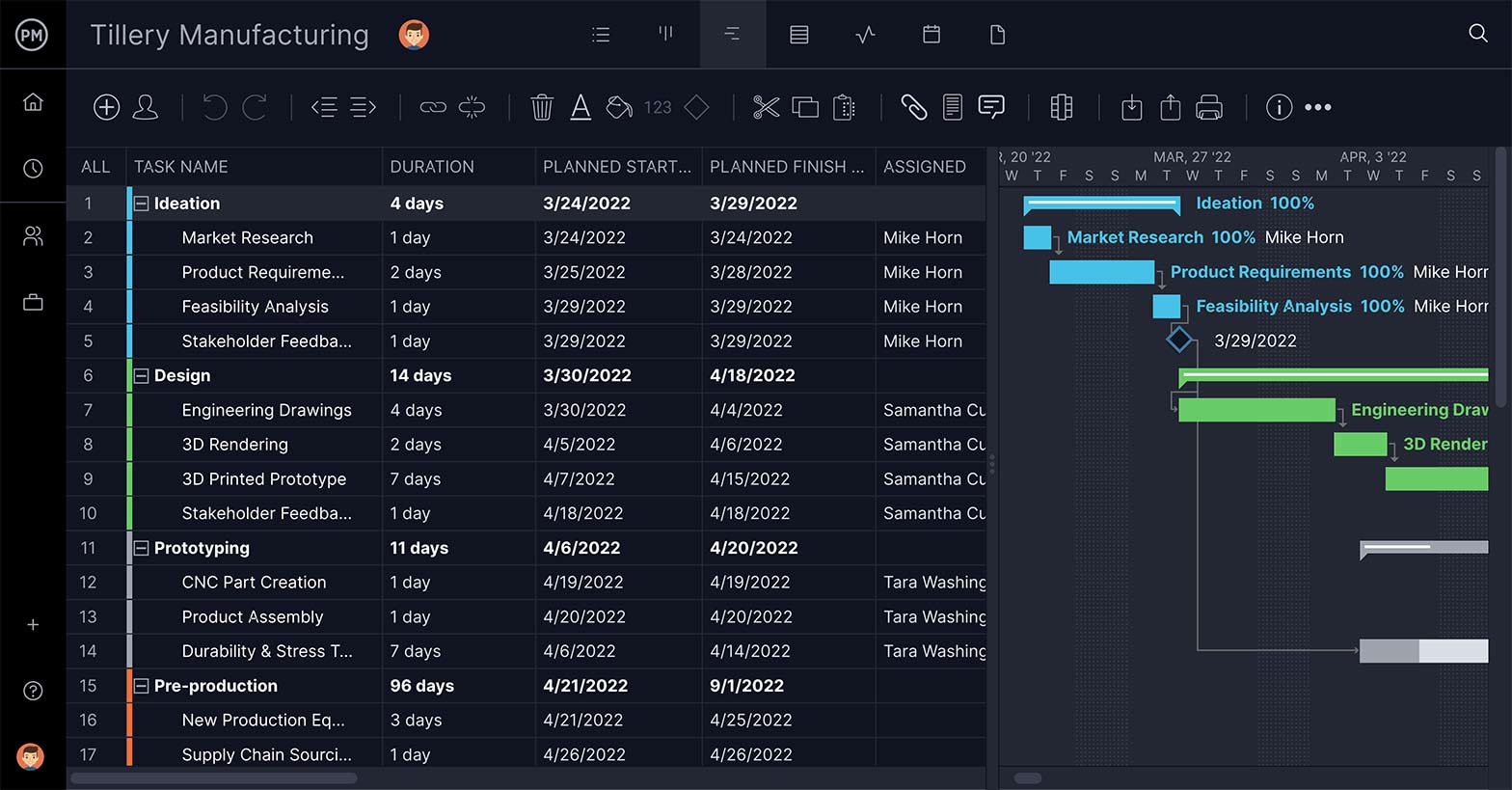
View Your Marketing Plan Status in Real Time
As teams update their status, it’s reflected on the Gantt. But the live data is also fed and automatically calculated on a real-time dashboard. Now you have an instant high-level status report whenever you want it, monitoring time, costs and much more.

Easily Generate Reports for Your Stakeholders
For more detailed reports or to update your clients, use one-click reporting tools. There are reports on workload, timesheets and more that are easy to generate and share with clients to keep them in the loop. The reports can also be filtered to show just the information requested.

ProjectManager Has All That and More
Unlike other project management software, ProjectManager has tools to help you manage several marketing plans with one tool, using a roadmap to see how you can more efficiently manage resources. Manage numerous advertising pushes at once and get a portfolio dashboard to help you monitor progress and performance. No other tool is as easy to use and effective at organizing your work.
What Other Templates Can Help Your Marketing Plan?
If you need time to make a decision about subscribing to project management software, there are dozens of free project management templates on our site that address planning. Here are just a few.
Work Breakdown Structure Template
As stated above, an essential part of any marketing plan is detailing the tasks you have to complete. If you miss any, it can negatively impact your budget, schedule and derail the entire campaign. That’s where a work breakdown structure template comes in. It’s a tool that thoroughly captures every step of your project, making sure there are no costly surprises.
Work Schedule Template
Once you have those tasks lined up, you need to assign them to people in the marketing team and maybe contractors as well. To organize all those various jobs and keep your team working and organized, you need our free work schedule template. It has space for your to note what days your team is working on a project, a task and even collects pay rates and hours spent on their assignments.
Production Schedule Template
If your campaign includes you producing ad materials, you’ll want to use our free production schedule template. It allows you to organize getting your promotions to the target audience by coordinating deadlines and the raw materials you need to procure to create those marketing assets.
Related Content
If you’re looking for more information on marketing plans or planning in general, take a moment to visit ProjectManager’s website. It’s a hub for all things project management, including weekly blogs, tutorial videos and guidebooks for an in-depth look at the various aspects of planning, monitoring and reporting on one or more projects. Here are a few to get you started.
- 10 Free Marketing Templates for Excel, Word and More
- How to Make a Marketing Plan Like a Project Manager
- Why Marketing Teams Absolutely Need a Project Manager
- 3 Project Management Tool Tips for Marketing Teams
Marketing is just a project, which means it’s made up of work with a beginning and end that results in some deliverables. Marketers would then obviously benefit from using project management tools. ProjectManager allows them to better organize their work efficiently. Join the tens of thousands of teams who are using our tool Sign up for your free trial today.
